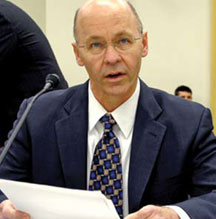Veterinarians warn Congress about dangers of veterinary shortage


AVMA officials recently testified in separate hearings to explain the harmful consequences of too few veterinarians working in public health and to encourage congressional support for initiatives shoring up the low supply of veterinary manpower.
On Jan. 23, Dr. Ron DeHaven, AVMA executive vice president, was one of four veterinarians to appear before the House Energy and Commerce Subcommittee on Health to speak in support of the Veterinary Public Health Workforce Expansion Act. Dr. DeHaven said a national shortage of veterinarians is putting the food supply at risk and could hinder efforts to prevent the spread of zoonotic diseases.
Then on Feb. 7, AVMA President Gregory S. Hammer testified before the House Subcommittee on Livestock, Dairy, and Poultry about how the delay in implementing the National Veterinary Medical Service Act—another measure aimed at solving the veterinary shortage—is putting U.S. economic health and food safety in jeopardy.
The workforce expansion act would create a competitive grants program designed to produce more veterinarians and enhance the country's capacity for research on diseases that threaten public health and food safety. The program would provide federal funding to build more classrooms, laboratory space, and support facilities at the country's veterinary colleges, which are currently at or above capacity and graduate only about 2,500 veterinarians annually.
Veterinarians are uniquely positioned to view health through the lens of public health impact and to understand how human and animal health interact. if we don't address the shortage of veterinarians and lack of capacity in veterinary schools soon, we'll find ourselves dangerously underprepared and ill-equipped to deal with future public health threats.
– U.S. Rep. Tammy Baldwin of Wisconsin
The number of veterinarians available to serve society in these key public health positions does not meet demand, Dr. DeHaven told the subcommittee. He cited a study that projects the shortage will worsen by 4 percent to 5 percent annually, well into the next decade.
"According to a recent report by the Bureau of Labor Statistics, veterinary medicine ranked ninth in the list of the 30 fastest-growing occupations," Dr. DeHaven said. "It is estimated that jobs for veterinarians will increase by 35 percent in the next several years. It is our collective responsibility to ensure that there are veterinarians to fill those positions.
"U.S. representatives Tammy Baldwin, a Wisconsin Democrat, and Charles Pickering, a Mississippi Republican, are chief sponsors of the legislation, introduced last year.
"Veterinarians are uniquely positioned to view health through the lens of public health impact and to understand how human and animal health interact," Baldwin said. "If we don't address the shortage of veterinarians and lack of capacity in veterinary schools soon, we'll find ourselves dangerously underprepared and ill-equipped to deal with future public health threats.
"Joining Dr. DeHaven at the hearing was Dr. Alan M. Kelly, Gilbert S. Kahn dean emeritus of the School of Veterinary Medicine at the University of Pennsylvania; Dr. Marguerite Pappaioanou, executive director of the Association of American Veterinary Medical Colleges; and Dr. Sheila W. Allen, dean of the College of Veterinary Medicine at the University of Georgia.
At his hearing before the House subcommittee, Dr. Hammer urged the Department of Agriculture to implement the National Veterinary Medical Service Act. Signed into law by President Bush in 2003 and funded in fiscal years 2006-2008, the act is a loan repayment program for veterinarians who pledge to practice in a variety of underserved areas of veterinary medicine, including food supply veterinary medicine.
With the average veterinary school graduate's debt climbing to $106,000, the program is essential if more food supply veterinarians are going to be added to the workforce, Dr. Hammer said.
"These food supply veterinarians are the guardians of our nation's food supply, and they will be the first medical professionals to diagnose and contain diseases in animals that may spread to humans," Dr. Hammer said.
Officials with the USDA testified that they lack the capability to administer the loan repayment program. They also indicated that the law's language complicates the process by not allowing them to work with the nation's veterinary colleges to coordinate the program.
Subcommittee members, however, questioned why USDA considers the act hard to implement.
"In crafting this act in 2003, the committee worked closely with USDA to ensure proper implementation of a simple and straightforward program that would allow USDA to offer incentives to large animal veterinarians to practice in under-served rural communities," said Subcommittee Chairman Leonard Boswell of Iowa. "It is frustrating that four years later, USDA is now bringing concerns to our attention.
"Representative Jack Kingston of Georgia, ranking member of the House Agriculture Appropriations Subcommittee, testified that Congress has appropriated about $1.9 million for NVMSA. He warned, however, that future funding may be at risk if the USDA doesn't implement the program.
"We will think long and hard before we put any more money into it without seeing any movement by USDA," he said.
Representative Steve Kagen represents an area of Wisconsin where the 500,000 farm animals are only slightly less than the 700,000 human residents. He encouraged the USDA to act quickly in implementing the law.
"This act is necessary," Kagen said, "because the animals can't fix themselves."